~~~~~~~~~~~~~~~~~~~~~~~~~~~~~~~~~~~~~~~


—————
Newspaper Accounts / Illustrations, 1898
w/ Page Book Numbers
~~~~~~~~~~~~~~~~~~~~~~~~~~~~~~~

U.S. Secretary of War Russell A. Alger
On August 4, 1898, Secretary of War Alger ordered Gen. Shafter’s Fifth Army Corps relieved of duty at Santiago de Cuba and to return by transport to Montauk Point.
Page 17 — Illustration, Boston Globe.
————————————–
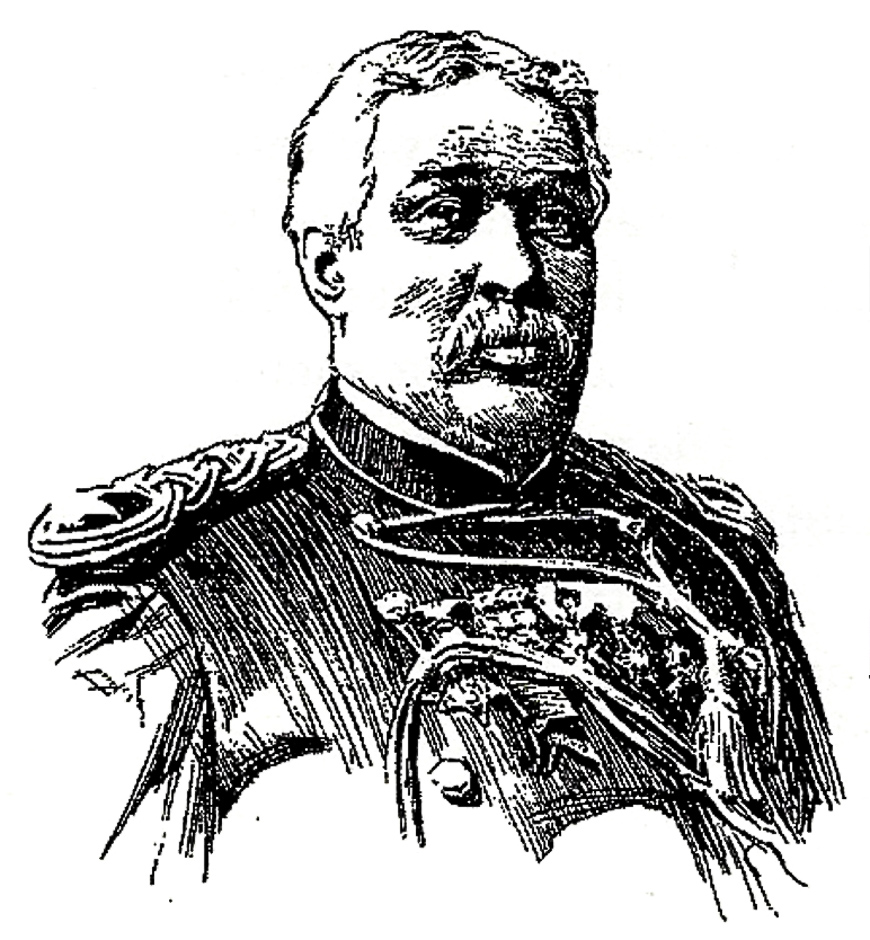
Major General Samuel B.M. Young
On August 6th, Gen. Young took command of the military camp in Montauk,
setting up headquarters at Third House.
Page 32 — Illustration, New York Herald.
————————————–
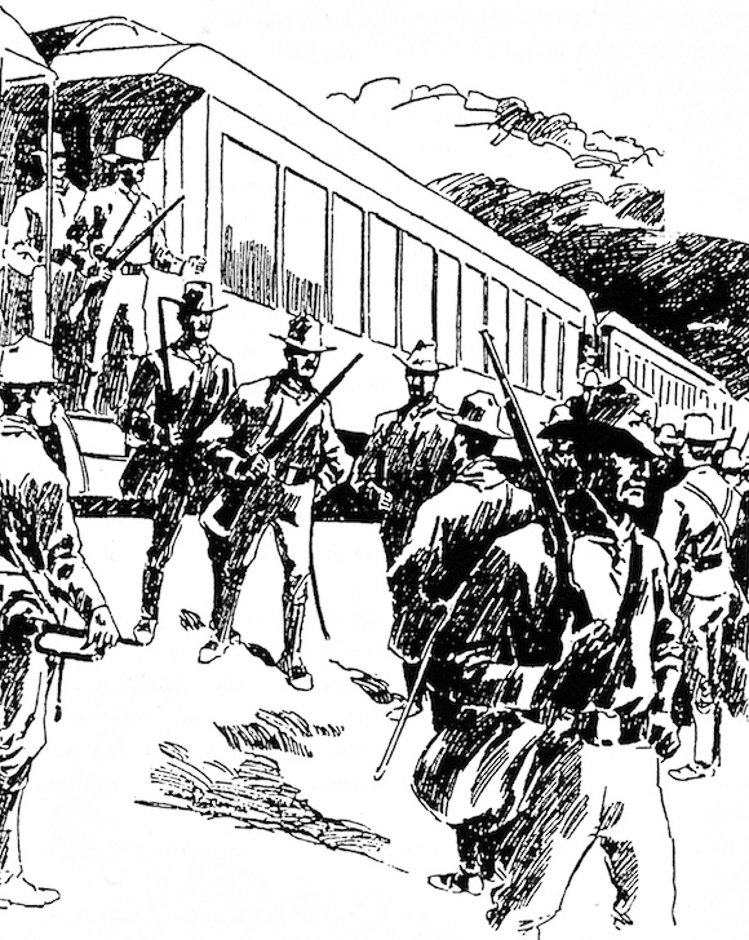
August 8th, Troops Begin to Arrive by Train from Southern Posts.
Seven thousand soldiers from southern posts at Fernandina and Tampa, Florida, were ordered to transfer by train to the camp at Montauk. This order included 500 Rough Riders that had remained in Tampa, as well as the regiment’s 1,200 horses.
— Illustration,
— Page 38 — Joseph Pulitzer’s The World, August 9, 1898.
.————————————–
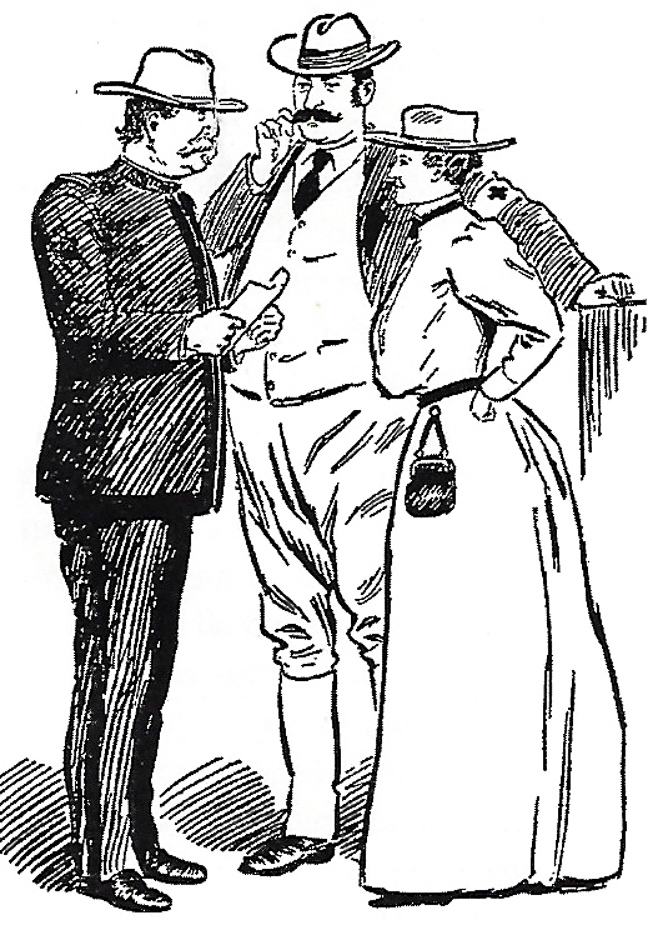
Colonel W.H. Forwood with American Red Cross Agent Howard Townsend
& Nurse Quintard, Head Nurse of the American Red Cross.
Page 41 — W.H. Shindler, Illustrator, New York Press.
————————————–
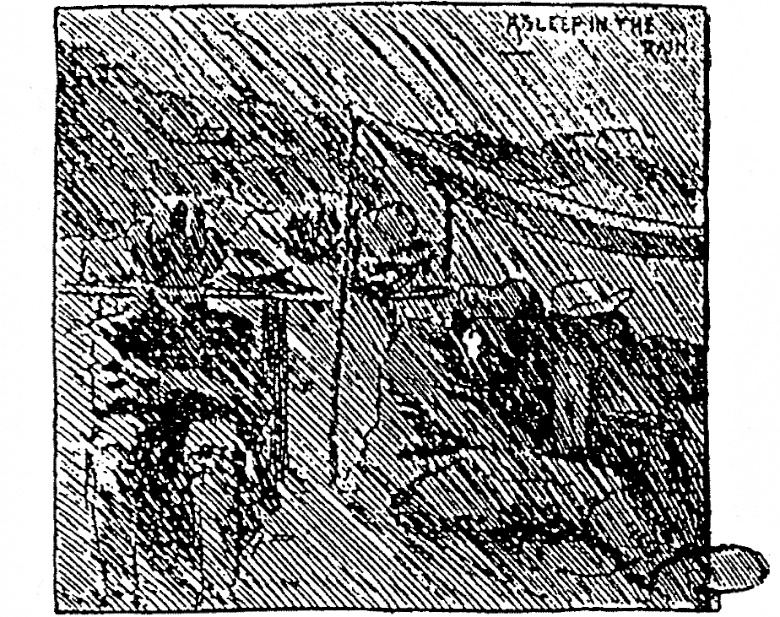
Asleep in the Rain
Page 43 — Illustration, The World, August 11, 1898.
————————————–
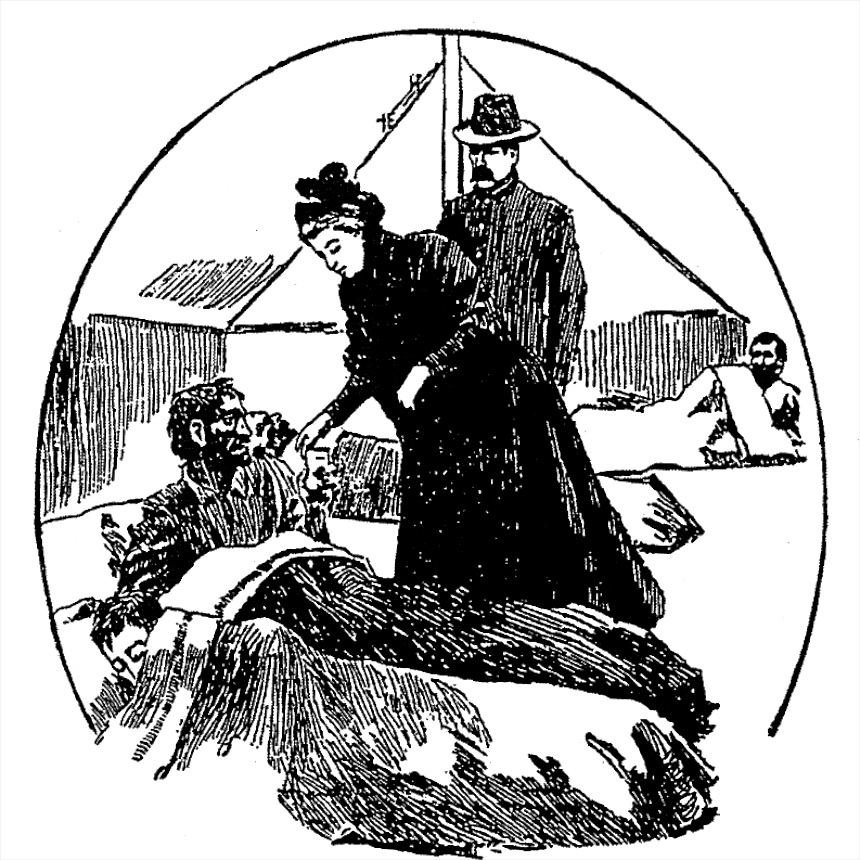
Ellen Hardin Walworth, Directress-General
Women’s National War Relief Association
Ellen Walworth was the Directress-General of the Women’s National War Relief Association, founded May 30, 1898 — Mrs. General U.S. Grant, President; Director-General Mrs. Ellen Hardin Walworth, Assistant Director, Helen Miller Gould.
-Page 51 – Illustration, The World, August 12, 1898.
————————————–
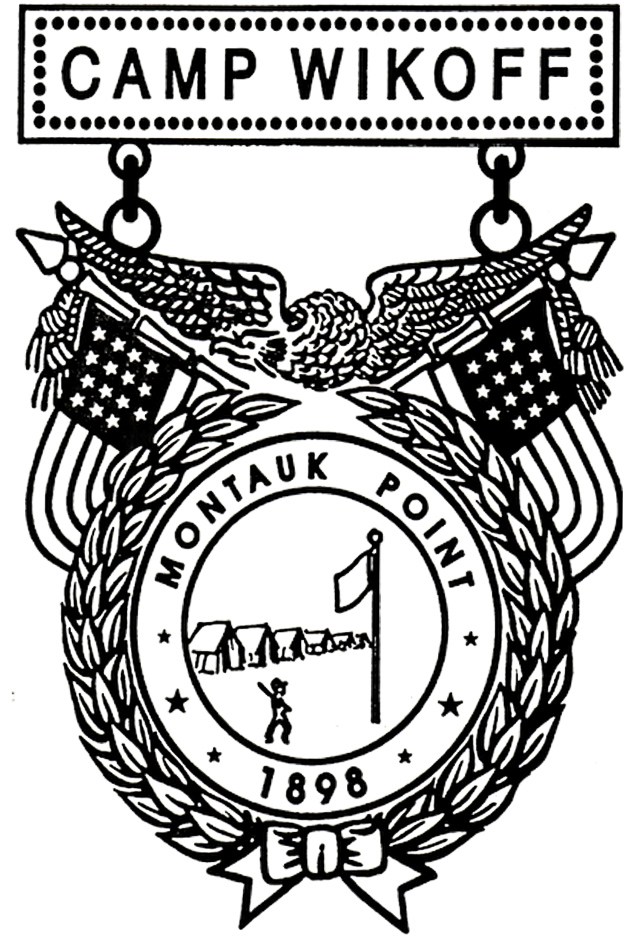
August 12 thru October 9, 1898
The military camp at Montauk was named in honor of Colonel Charles A. Wikoff of the Twenty-second United States Infantry, who was killed at the head of his brigade on July 1st, 1898, at Santiago.
— George Bloem, Illustrator.
— Page 46 — Report, New York Press, August 12, 1898.
————————————–

—————–
![]()
May the new Cuba that is to come be worthy of its grand sacrifices
and of the great American republic that has made it possible.
Page 251 — Boston Globe.
————————————–

————————————–
Leaving Santiago de Cuba on the Transport Gate City…
‘HOME, SWEET, HOME’
“We were the first transport away…and it was a grand sight to see those thousands of poor fellows giving us a send-off….And just as we pulled out, our band, which came along with us, started, ‘Home, Sweet, Home’….and the tears came to my eyes. That old song stirred us up, I can tell you, and it sent
our thoughts to home…”
— Third Cavalryman
— Page 56 — The Sun, August 15th
————————————–
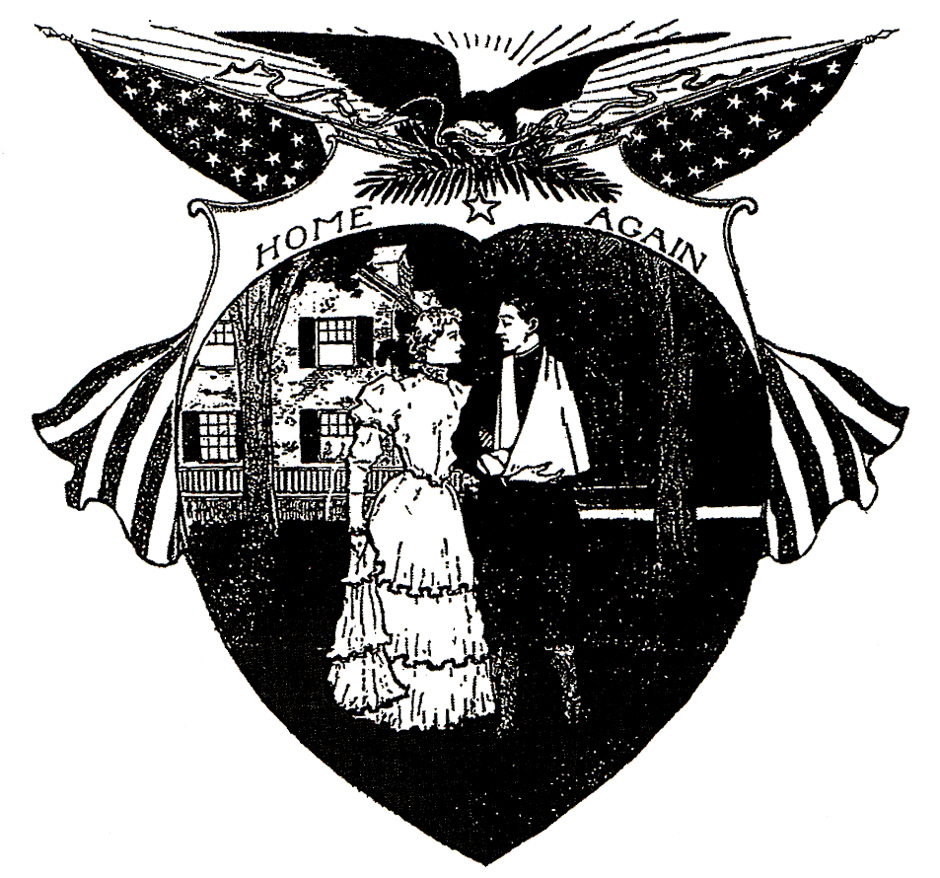
-Page 53 – Boston Globe.
————————————–
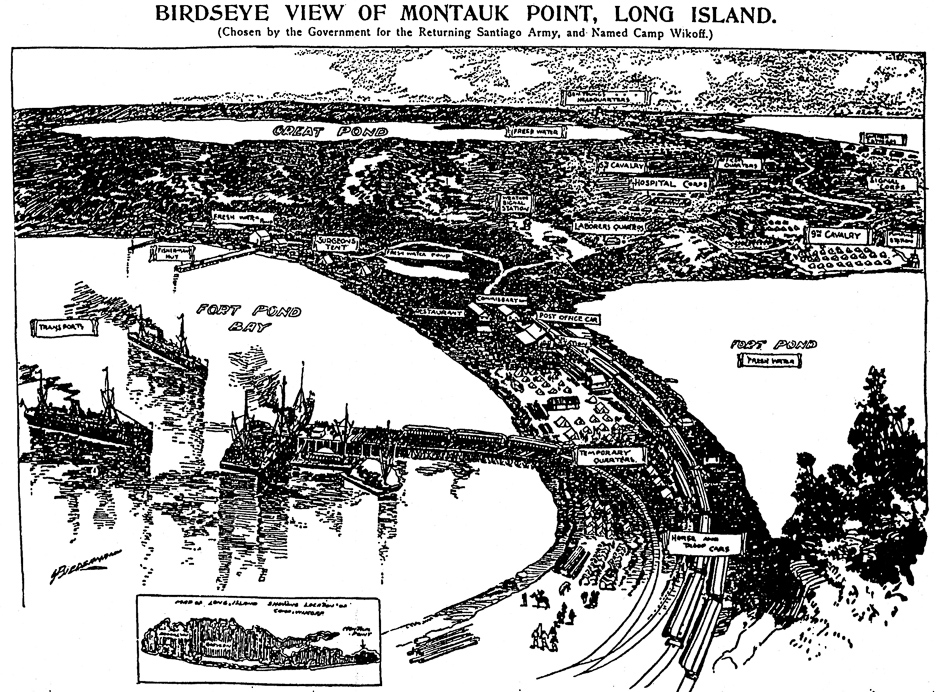
On August 13, 1898, the Gate City — first transport from Cuba — arrived at Fort Pond Bay, Montauk.
— Illustration, The World.

Area of the camp……………… 4,200 acres
Number of men who will be stationed in the camp ……………… 24,000
Number of horses ……………… 5,000
Number of tents ……………… 6,500
Food consumed per man each day ……………… nearly 4 pounds
Cost of food per man per day ……………… about 27 cents
Page 57 — The World
===========================================
ROOSEVELT AND WHEELER ASHORE
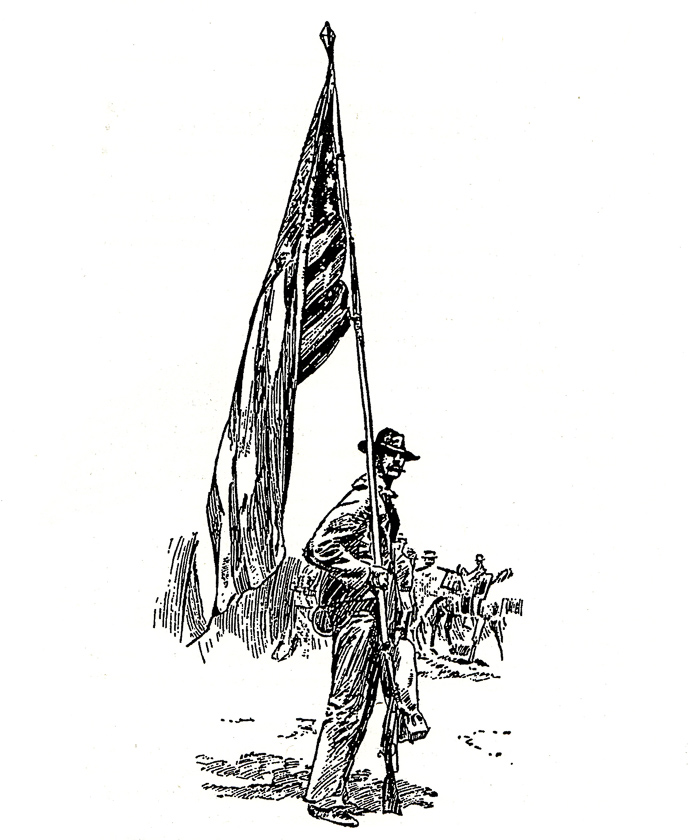
Colors and Color Sergeant Albert Wright of the Rough Riders
Page 60 — James Gordon Bennett, Illustrator.
————————————–
“How are you, Col. Roosevelt?” shouted an officer to Roosevelt, who was standing on the ship’s bridge as the transport Miami docked at the Iron Pier at Fort Pond Bay.
“I am feeling disgracefully well,” Roosevelt shouted in reply. “I feel positively ashamed of my appearance when I see how badly off some of my brave fellows are.”
Then, in tones of intense conviction, “Oh, but we have had a bully fight!”
Pag 62 — New York Herald, August 15, 1898.
————————————–
The Rough Riders
The Rough Riders are, of all regiments, the public’s favorite. They form the one regiment that belongs to no State. They represent the whole country, and Texas feels as much local pride in them as does New York. They represent no one walk in life and no one grade in society
…A more ideal commander for such a regiment could not be found than the gallant, dashing and impetuous Roosevelt.
Page 75 — Editorial, Commercial Advertiser. August 16, 1898.
When formation of the 1st United States Volunteer Cavalry was announced in April, 1898, there were 20,000 applicants from across the country. One thousand sixty were selected — all excellent horsemen & marksmen. Trained in San Antonio, then stationed in Tampa — 500 went to Cuba in June and 500 with held in reserve in Tampa.
————————————–
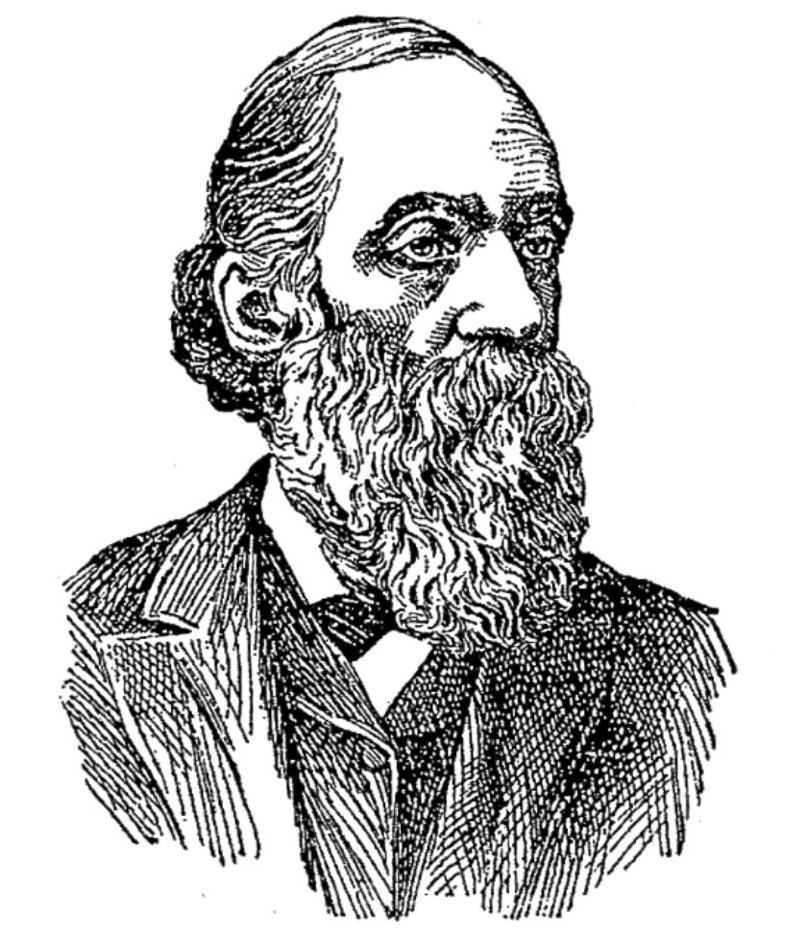
Major General Joseph ‘Fighting Joe’ Wheeler
On August 15, 1898, Gen. Wheeler debarked the transport Miami and was in command of Camp Wikoff from August 19th thru September 4th. A Confederate General in the Civil War, Wheeler afterwards rose to the rank of General in the US Army, and came to personify the unification of the country following the Civil War. Wheeler graduated from the United States Military Academy at West Point in 1859.
Page 80 — Illustration, Boston Globe, August 16, 1898.
————————————–

Theodore Roosevelt & Woodbury Kane, Rough Riders
-Page 65 — W.H. Shindler, Illustrator.
— New York Press.
————————————–
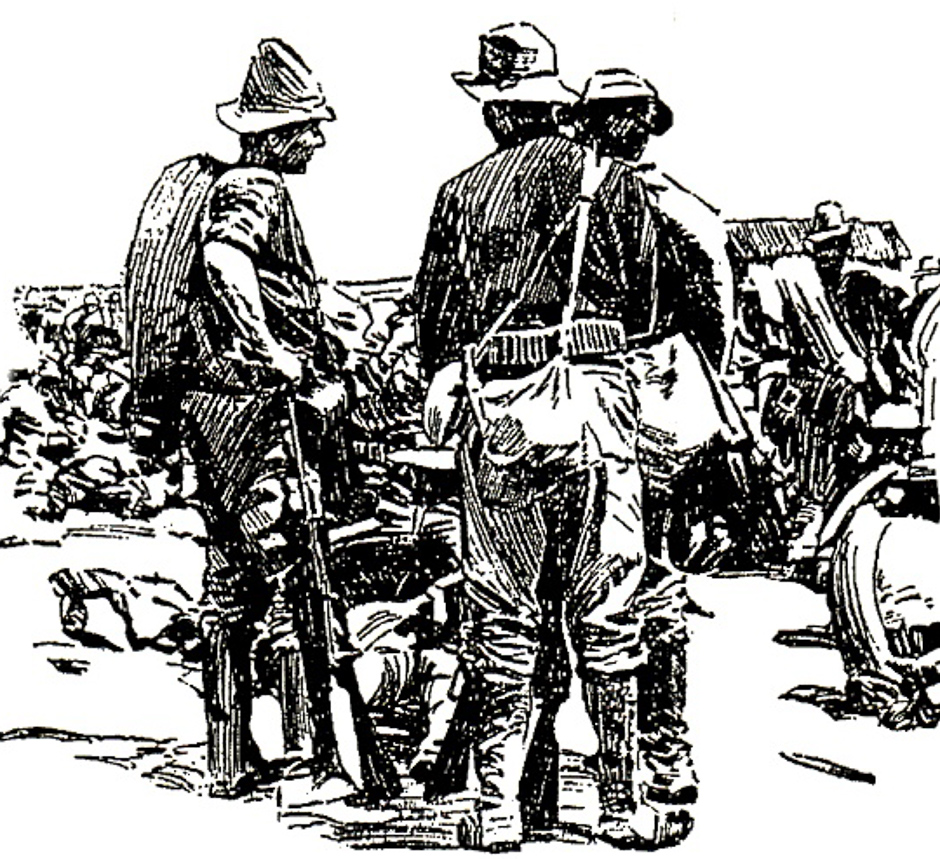
Rough Riders Wrenn, Larned and Bull
Page 67 — New York Herald, August 17, 1898.
————————————–

Watching for Transports.
Page 88 — Chambers, Illustrator. The World, August 19, 1898.
————————————–

Col. Roosevelt and his wife, Edith, stayed at Third House on August 19 & 20th, 1898. Edith, Alice and Ethel stayed there September 7th — Theodore Jr. & Kermit stayed in Col. Roosevelt’s tent overnight.
— Page 91 — NY Times Report, August 19, 1898.
————————————–
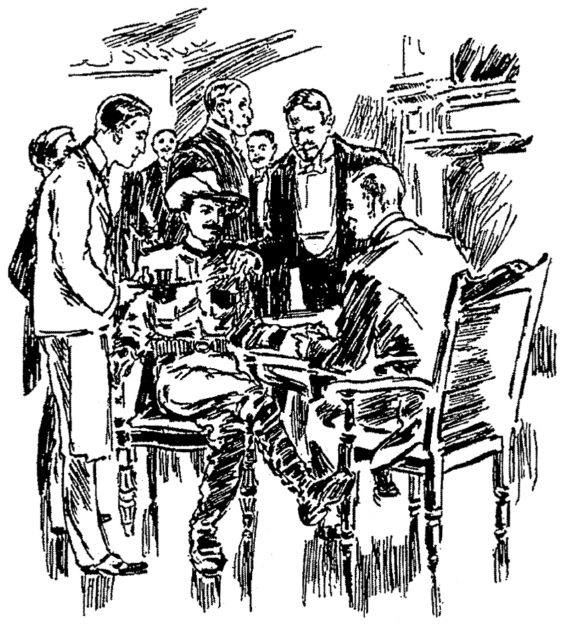
Rough Rider Craig Wadsworth surrounded by friends
at the Knickerbocker Club, NYC.
— Page 103 — Illustration, New York Herald, August 20, 1898.
===========================================
“We have everything,” said a young lieutenant,
“we have life and we have death.”
— Commercial Advertiser, August 24, 1898.
===========================================
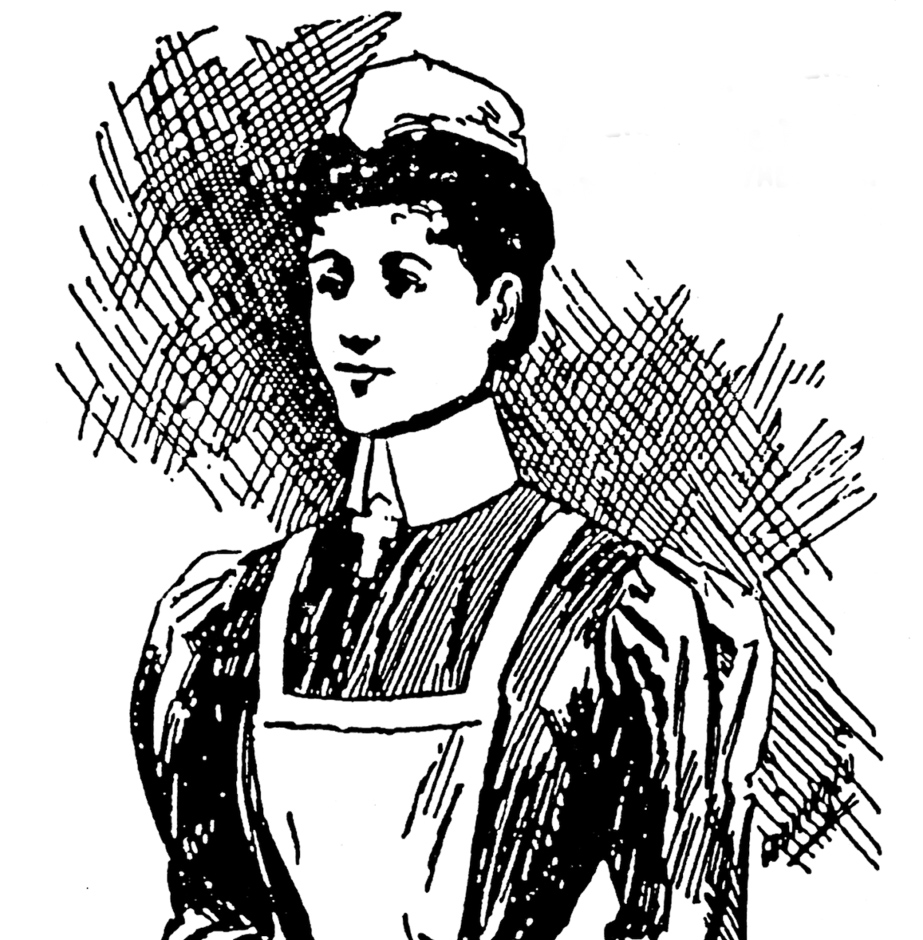
Nurse Annie Laurie Early Wheeler
Nurse Wheeler was the only non-immune Red Cross nurse to go to Santiago. She then applied to Col. Forwood and was assigned to Ward 1 at Camp Wikoff, where she tended to the care of forty patients.
Given the overwhelming number of fever-stricken soldiers arriving at Camp Wikoff, or expected to arrive soon, the United States Government, for the first time, contracted with nurses of the American Red Cross to serve in the General and Detention Hospitals at the camp, a service traditionally restricted to male nurses.
Page 119 / 121 — Illustration & Report, The World, August 25, 1898.
————————————–

Reports on the condition of the returning troops
— fever-stricken & malnourished — angered Americans across the country.
-Page 128 – Homer Davenport, Illustrator.
— William Randolph Hearst’s New York Journal, August 26, 1898.
—————————————
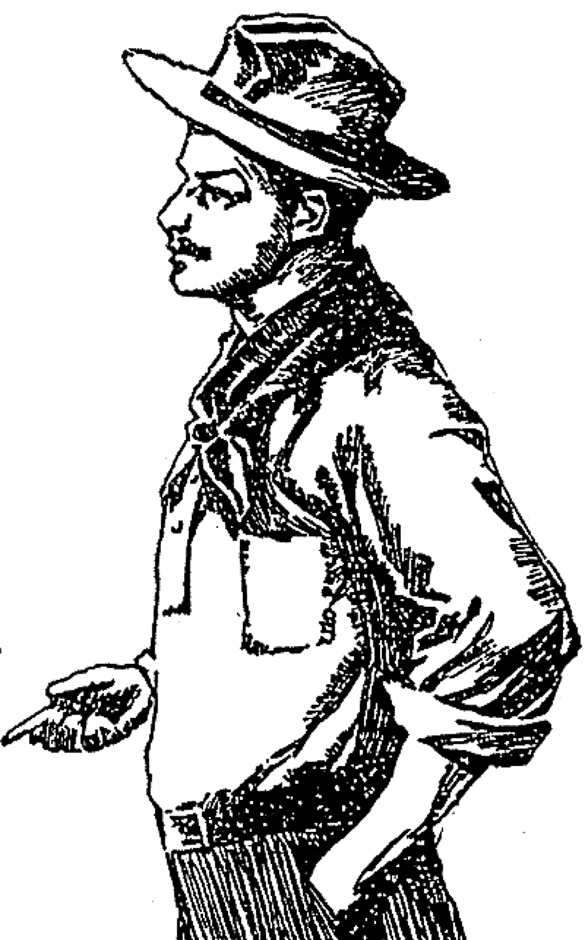
Lieutenant William Tiffany, Rough Riders
Lieut. Tiffany, suffering from malnutrition, returned by transport to Fort Pond Bay from Santiago de Cuba, but remained on board the transport waiting for provisions for six hours before continuing to Boston, where he died of ‘starvation’ on August 25, 1898.
A member of the Knickerbocker Club, he was a grandnephew of Commodore Perry and a nephew of August Belmont.
— Report, New York Times, August 25, 1898.
Page 129 — Illustration, The World, August 26, 1898.
————————————–
![]()
Think of an American soldier dying of starvation after fighting
and helping to win a glorious battle for his country! …
Page 130 — Editorial, Kansas City Star, August 26, 1898.
————————————–
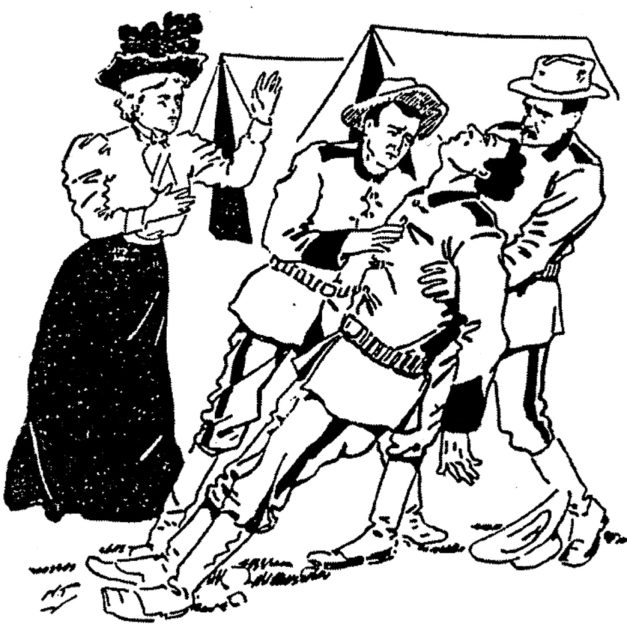
John Hawthorne, New York Seventy-First
The grandson of Nathaniel Hawthorne made a splendid record for heroism at Santiago with the brave Seventy-first, but when his mother found him at Camp Wikoff, he was so emaciated and weak that he fainted at the joy of seeing her.
Journalist Julian Hawthorne, son of Nathaniel Hawthorne, was the father of John Hawthorne.
Page 141 — Illustration, New York Journal, August 27, 1898.
————————————–
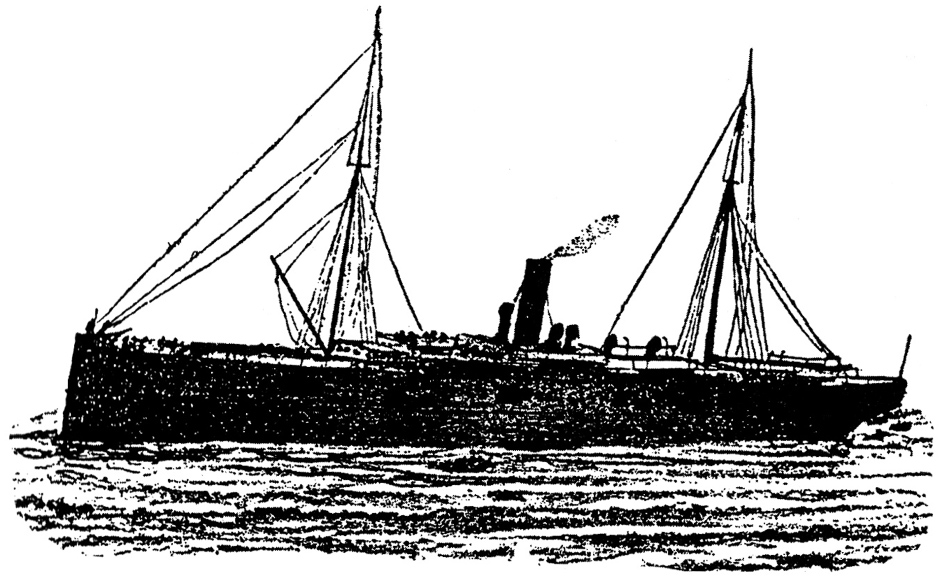
Auxiliary Cruiser Prairie
The Prairie, with 400 American soldiers on board — 100 of whom were sick — grounded on a sand bar between Amagansett and Napeague Beach in a heavy fog between 8 and 9 the night of August 26th. It was thought that the ship’s captain had mistaken the Ponquogue Lighthouse, Hampton Bays, for the Montauk Point Lighthouse, then, in the thick fog, made the turn to round the Point too soon and “dug her nose so deeply into the sand that the efforts of her engines to pull her off again were futile.”
“For miles around people came to help in the work of taking these unfortunates ashore…”
Page 133 — The Sun, August 27, 1898.
————————————–
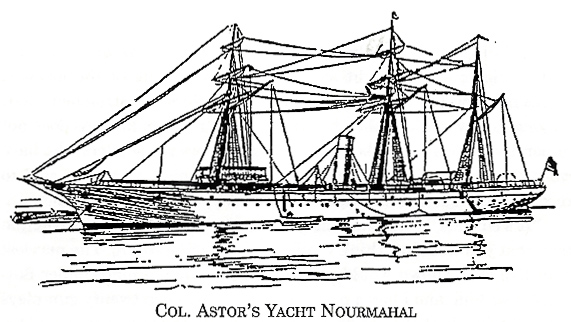
On August 28th, Col. John Jacob Astor IV of Newport sailed to Montauk Point on his yacht Nourmahal, in company with Mrs. Victor Sorchan, Mrs. Ogden Mills, and Fernando Yznaga, with the choicest delicacies and needed food. Cornelius Vanderbilt also contributed to this mission.
— Illustration, New York Herald.
Page 147 — Report, New York Times, August 27, 1898.
————————————–
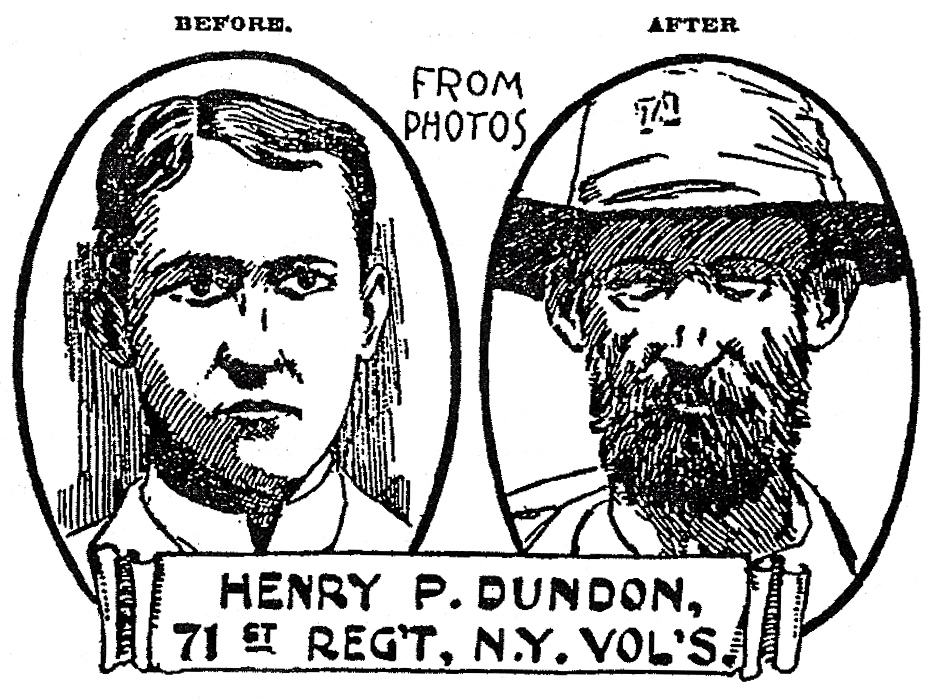
Before the War & After the War Portraits.
Page 78– Illustration, The World, August 28, 1898.
————————————–
To the Editors of the New York Times:
….Now, who is Alger, who dares to say to the American people that the conduct of the departments
responsible for the past and present disgraceful condition of affairs in the army is magnificent? …
Each unavenged victim of the crime of the War Department will cost the Republican Party thousands of votes….The political history of this country shows that the people do not forget crimes…
For campaign purposes, ‘Remember Camp Wikoff’
may be as effective as ‘Remember the Maine’.
Samuel L. Parrish
— New York Times, August 28, 1898.
————————————–

Page 144 — Fanny Cory, Illustrator, The World, August 28, 1898.
————————————–
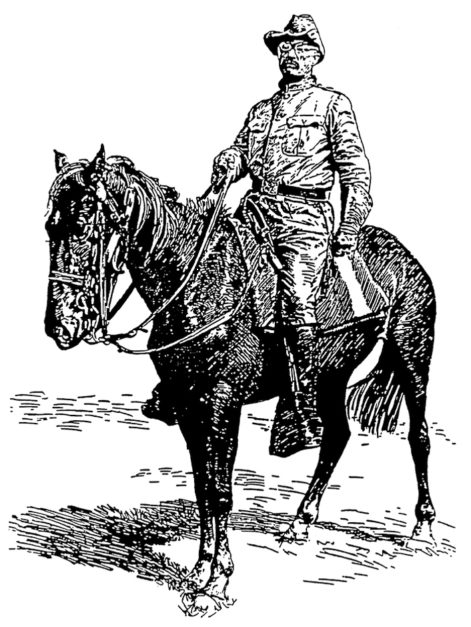
Colonel Theodore Roosevelt, Rough Rider
“Col. Roosevelt led that famous charge on horseback to the first blockhouse on San Juan Hill….His escape from death was simply miraculous.” — Capt. Maximilian Luna, Rough Rider.
— Illustration, New York Press.
Page 149 — Report, The World, August 28, 1898.
————————————–
“The Real, Genuine Stuff”
“All the volunteers fought hard,” said a Cavalry Sergeant, “but those Rough Riders–
look at that now, look at those two just riding up there. See how their arms are fixed
–just right; and their seat comfortable, deep down in the saddle,
and their hats–look at the hats.
Oh, say, they’re the stuff, they are; the real, genuine stuff.”
— The Commercial Advertiser.
————————————–
The Slouch Hat
The United States Army never did a more fashionable and practical thing than when it adopted the slouch hat for the rank and file — the soft, round, limited sombrero, with the broad brim — just wide enough to take on beautiful curves bending down under the sun or up before the wind, giving always perfect lines, artistic form.
— Report, Commercial Advertiser.
— Illustration, New York Press, August 28, 1898.
————————————–
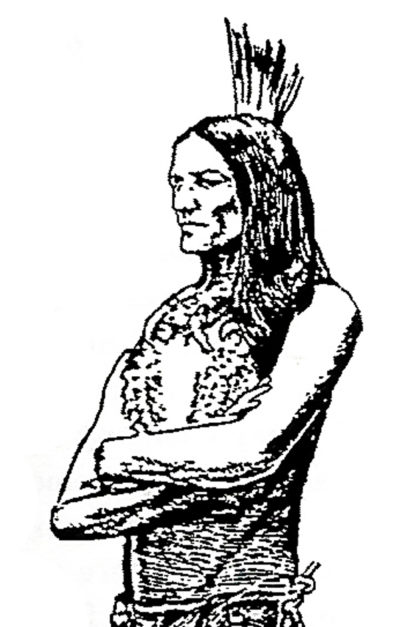
Cherokee Bill, Rough Rider.
His skill with rifle and revolver is a constant source of wonder and delight to his comrades.
— Illustration & report, The World.
————————————–


The Rough Riders’ Mascot
Thirteen year old Dabney Royster hid in an army wagon as several troops of the Rough Riders passed through Memphis, Tennessee. With his father’s permission, Dabney then went with the Rough Riders to Cuba, but the soldiers would not let him within half a mile of the fighting. He became a mascot protege of the Rough Riders, returning with them to Montauk on board the transport Miami, and later said that he wanted to be “a soldier all the time.”
— Illustration & report, The World, August 28, 1898.
————————————–

Soldier carries his sick ‘bunkie’ ashore.
More than half the soldiers arriving by transport were suffering from tropical fevers — malaria, typhoid, dysentery, and, in a few cases, yellow fever. More than sixty died on board returning transports and were buaried at sea.
Page 168 — Illustration, New York Journal, August 25, 1898.
————————————–
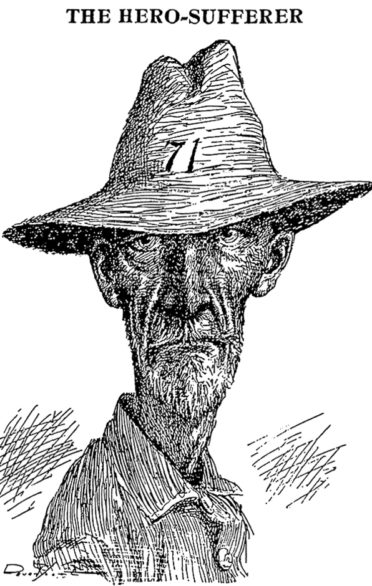
71st New York Volunteers
“The Man or Men Responsible for This
Must Answer to the People for the Awful Horror.”
Page 174 — Homer Davenport, Illustrator, New York Journal
————————————–
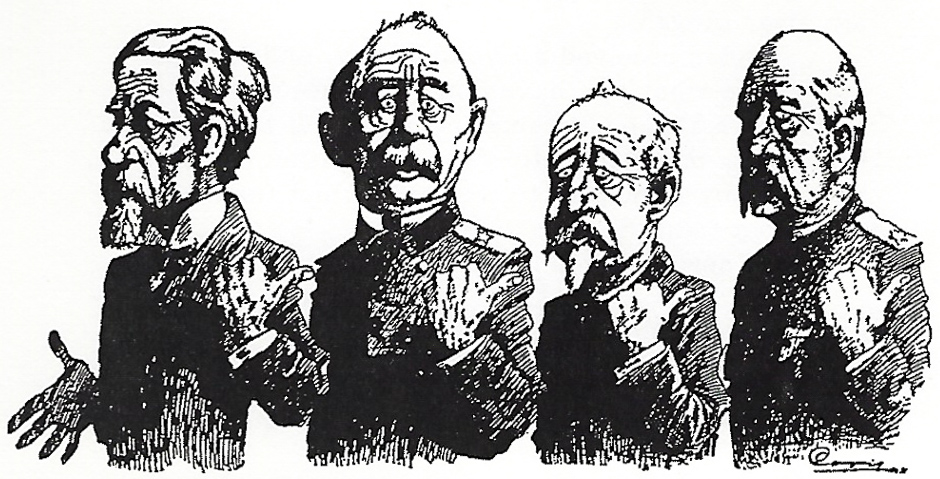
“Chorus — It’s His Fault.”
Secretary of War Alger, Surgeon-General Sternberg, Commissary-General Eagan, Quartermaster Gen. Ludington.’
Page 177 — Fanny Cory, Illustrator, The World
————————————–

B Company, First Illinois
First Meal On Shore At Montauk Point
Page 179 — Illustration, Chicago Tribune.
————————————–
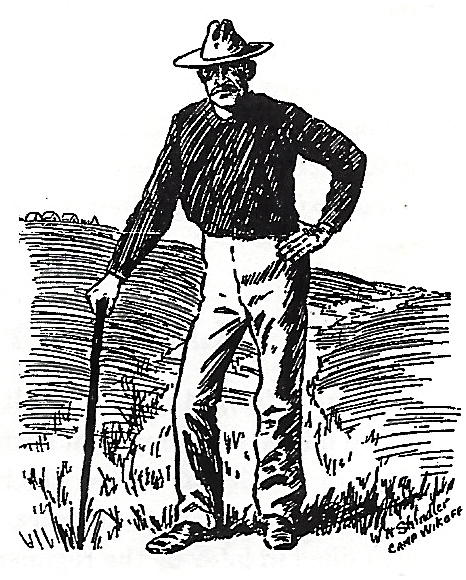
James B. Douglas, Rough Rider
Oldest soldier in the regiment — he was shot in the side at the Battle of Las Guasimas and is ill from rheumatism contracted in the trenches in front of Santiago.
Page 179 — W.H.Shindler, Illustrator. New York Press.
————————————–
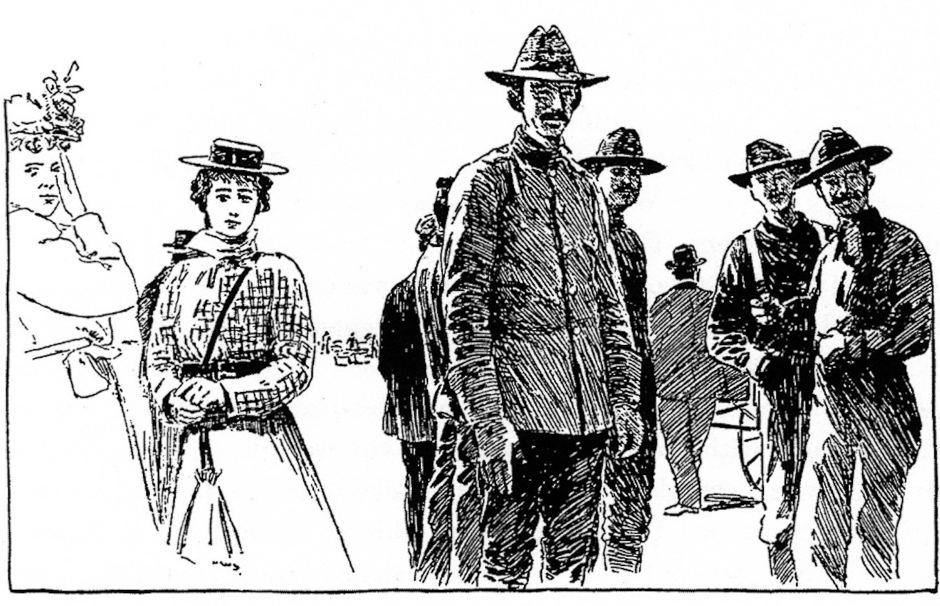
Capt. Higgins of the Fifteenth US Volunteer Signal Corps,
entrusted with laying out Camp Wikoff.
Captain Higgins, 25, was a graduate of the University of Pennsylvania — a lawyer, surveyor, civil engineer, electrician, telegraph operator, photographer, and draughtsman.
Page 181 — Illustration, New York Press, August 27, 1898.
————————————–
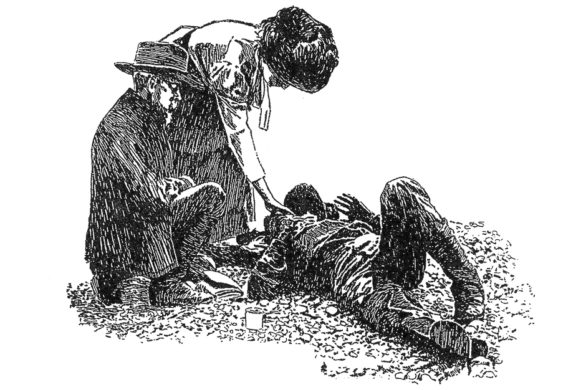
MILK FOR A PROSTRATE REGULAR
Surgeon Aby and Mrs. Mott found this soldier of the Third Infantry
in the agony of death on the ground at Camp Wikoff.
Page 219 — Haydon Jones, Illustrator, The World, August 27, 1898.
—————————————

VICTOR–AND VICTIM
Page 185 — Charles Nelan, Illustrator. New York Herald, August 30, 1898.
————————————–
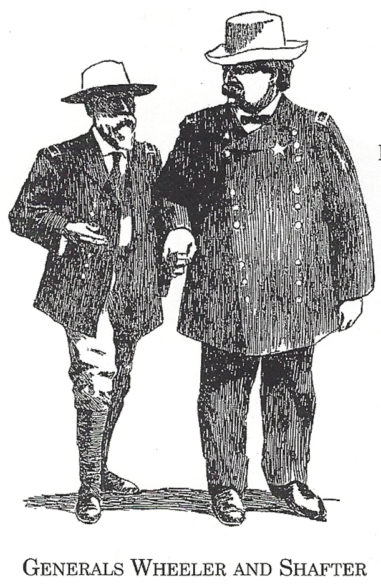
On August 31st, General William Shafter arrived at Camp Wikoff on board the transport City of Mexico.
He assumed command of the camp on September 5th.
Page 214 — Haydon Jones, Illustrator, The World.
————————————–
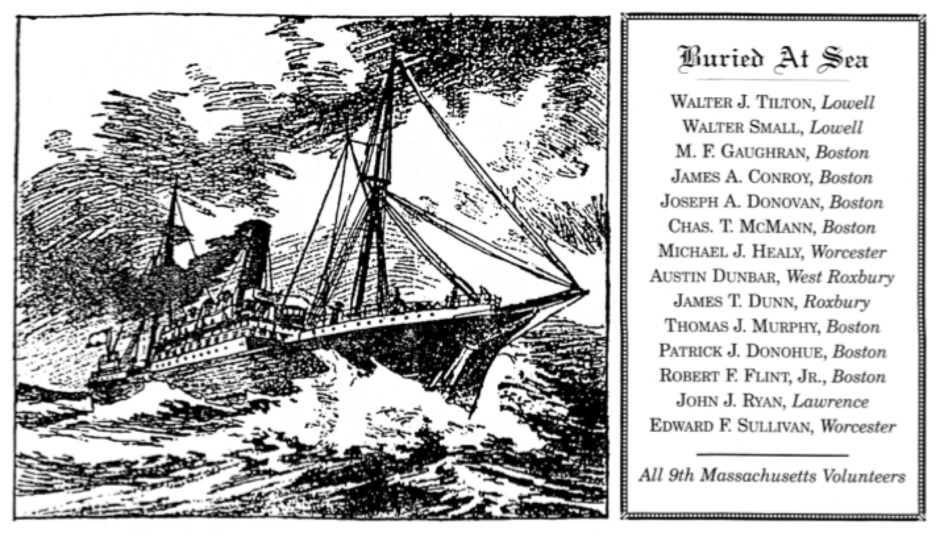
The Transport Allegheny — with 145 sick of the 480 men on board — buried 13 men at sea en route to Montauk.
“The ship was not fit to put well men on,” said Dr. Magruder. “It was hardly less than criminal to load her with sick men. She is a cattle ship.”
Page 192 — Illustration, New York Evening Journal, August 31, 1898.
————————————–

Page 195 — Heyer, Illustrator, The World, September 4, 1898.
—————————————

Volunteer Nurse Miss Cherrie M. French
‘Succumbed to Exhaustion’
Miss French left a life of comfort in Connecticut to serve
as a nurse at Camp Wikoff, giving her services without charge.
— Illustration, The World.
================================================================

**************** Saturday, September 3, 1898 ******************
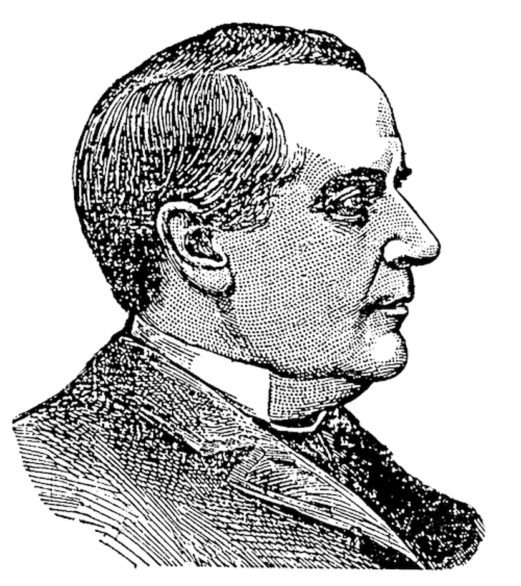
President William McKinley
Commander-in-Chief of the Joint Forces
———————————-

President McKinley Escorted Through the General Hospital by Gen. Wheeler.
— Illustration, Boston Globe.
———————————-
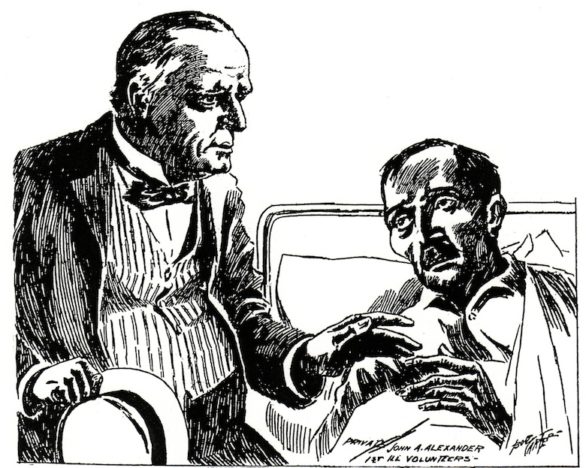
Private John Alexander, 1st Illinois Volunteers, Calls on the President to Visit Him.
— Carter, Illustrator, The World.
———————————-

President McKinley Addresses Soldiers of the Fifth Army Corps
Gathered on Montauk’s great plain, the President told the soldiers, “You have come home after two months of severe campaigning, which has embraced assault, siege and battle — so brilliant in achievement, so far-reaching in results as to earn the unstinted praise of all your countrymen.
“You had the brunt of the battle on land. You bore yourselves with supreme courage, and your personal bravery, never before excelled anywhere, has won the admiration of your fellow citizens and the genuine respect of all mankind, while your endurance under peculiar trial and suffering has given added meaning to American heroism.”
— Illustration, New York Herald.
———————————-
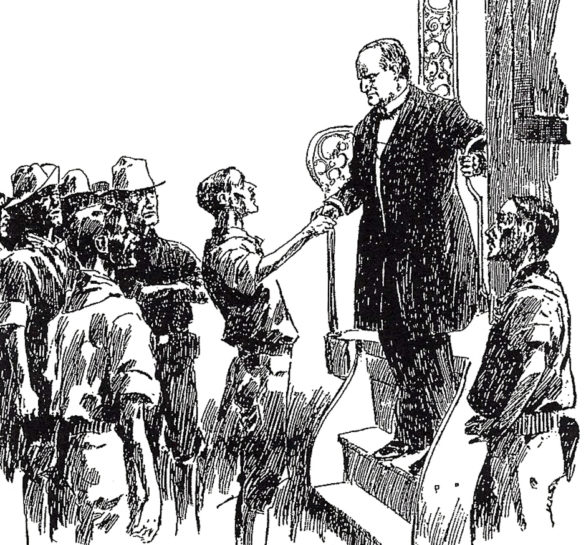
Soldiers Plead to be Sent Home.
— Illustration. The World.
————————————–
================================================================
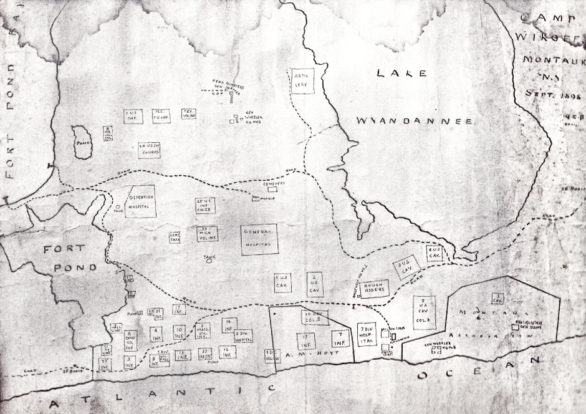
Camp Wikoff / Map Dated September, 1898
————————————–
A Fist-Fighters Opinion
“This country ought to go broke on the heroes. It ought to send home every man
who returned from the war as fit as when he enlisted and with money in his pocket.”
— Legendary Boxer John L. Sullivan
— The World, September 3rd, 1898.
————————————–
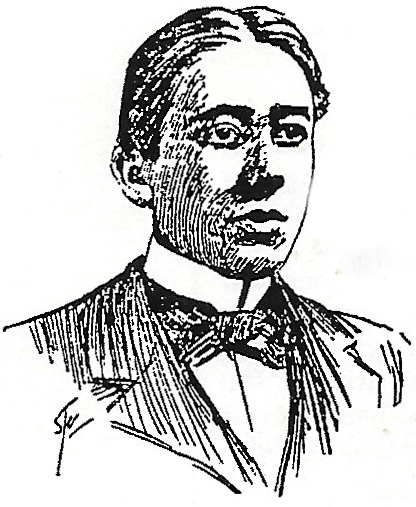
Dilwyn Bell, Rough Rider
When the woman saw the face of the man lying motionless on the ground,
breathing but unconscious —
his wasted figure proof of fever and starvation —
a shriek of anguish came from her lips,
“Dilwyn, my son, my son.”
— Illustration, Chicago Tribune, September 3, 1898.
————————————–
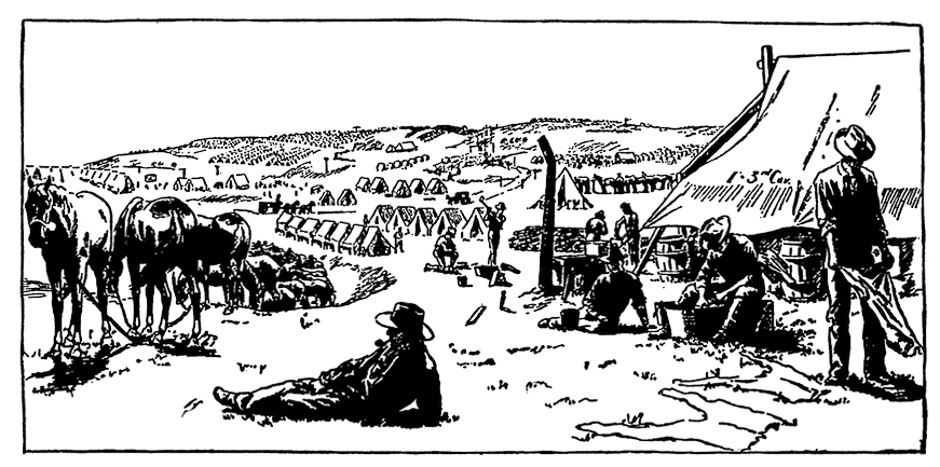
Sunday Morning at Camp Wikoff
— W.H. Shindler, Illustrator, New York Herald.
————————————–


Col. Roosevelt signed the Visitor’s Log when he visited the Montauk Point Lighthouse on September 6, 1898. Hundreds of soldiers visited the Lighthouse during their stay at Camp Wikoff.
————————————–
The writer will long preserve one brief impression of Col. Roosevelt as he stood at the mess tent, with his head up, his chest expanded, and his powerful arms outstretched, breathing deep of the fresh sea air.
“Oh,” he said, with a long sigh of prophetic regret, “I’ll miss this place when it’s all over!”
— The Sun.
————————————–

Helen Gould, Assistant Director-General of the Women’s National War Relief Association,
gave tens of thousands of dollars in relief aid to the hospitals at Camp Wikoff.
Helen was a daughter of financier Jay Gould.
— Illustration, New York Journal.
————————————–
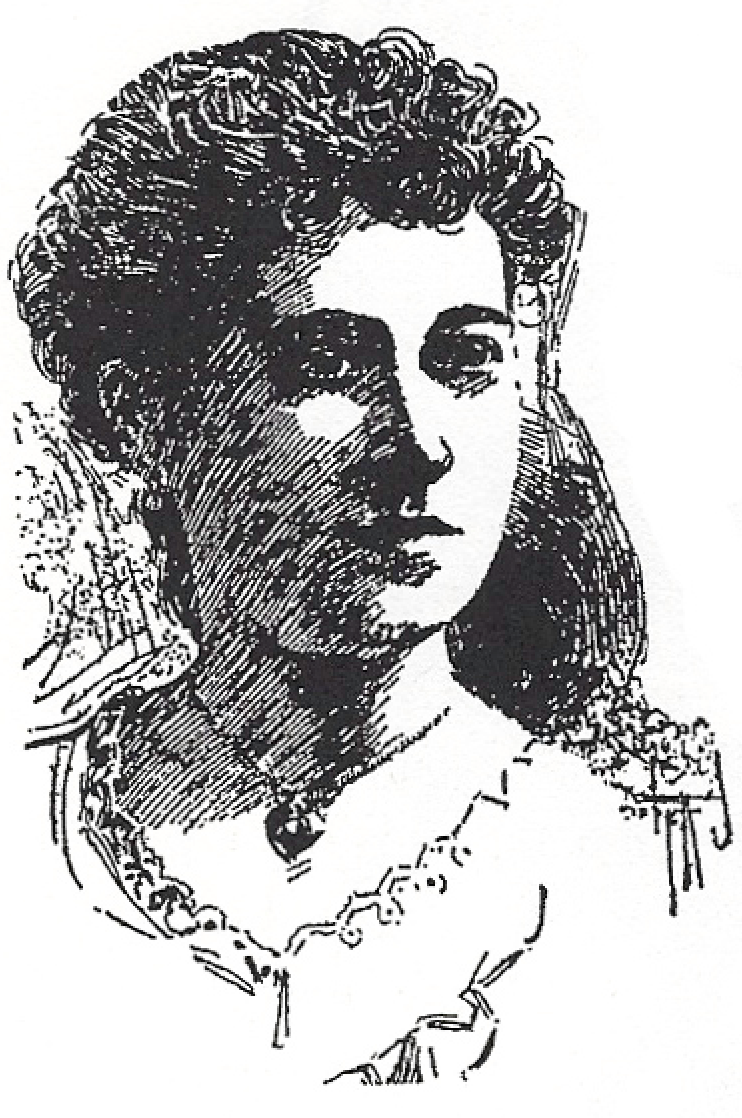
Miss Eleanor L. Coe, 23, a Volunteer Nurse at Camp Wikoff.
The demonstration of American women’s patriotism and unselfish devotion has helped to make glorious the war with Spain….The nurses at the hospital, the women who have everywhere cared for the sick and wounded soldiers, are as worthy of their country’s honor as the soldiers themselves.
— Illustration & Report, The World, September 9, 1898.
————————————–
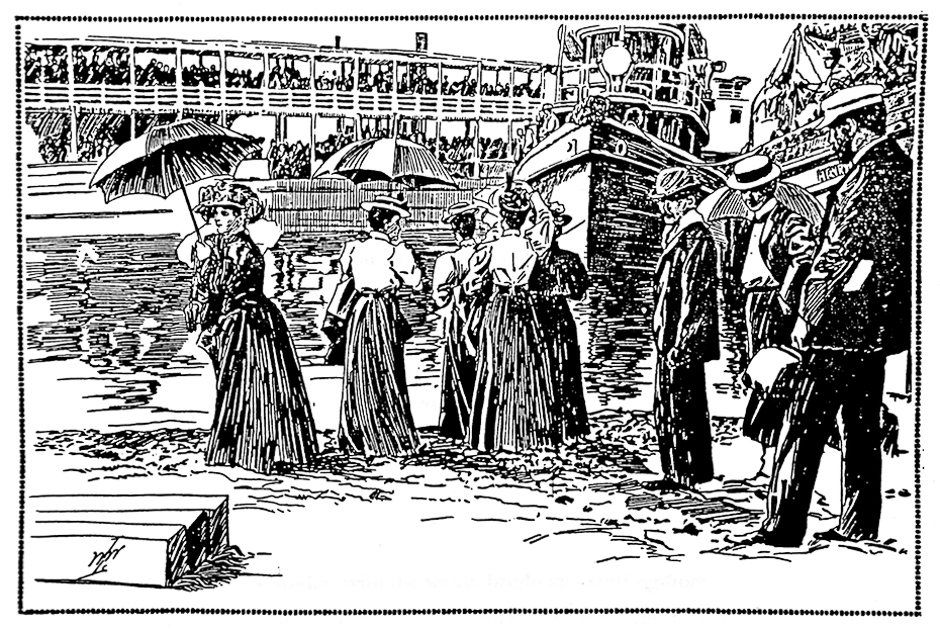
Chicagoans Greeting The Barge Bearing The First Illinois Boys
As It Neared The Pier At Montauk.
— Illustration, Chicago Tribune, September 5, 1898.
————————————–

Surgeon General Sternberg at Camp
“I found everything in excellent condition. There is plenty of medicine, physicians, and nurses in the hospital, and the patients are receiving all the attention that can be desired….The sanitary condition of the hospital is splendid….A better site than this could not be found anywhere this side of the Rocky Mountains….This is practically an island with deep water all around, and it has the additional benefit of being a railroad terminus.”
— Illustration, New York Herald.
— Report, New York Times, September 5, 1898.
————————————–
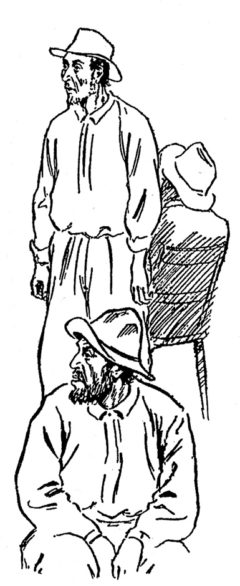
CAMP GHOSTS
The most pitiable sight that is to be seen hereabouts is the ‘ghost’ type…the man who isn’t ill enough to be admitted to the hospital, but is too ill to do duty. Therefore, he has nothing to do but wander, and he lacks the strength for this, but he always essays it, with the result that he drops by the wayside… “Such cases,” says one of the surgeons here, “are just about beyond treatment…The cause is the hardships of the campaign, repeated attacks of fever, and lack of nourishing food…”
— Illustration, New York Press, September 5, 1898.
— Report, The Sun.
————————————–


Naval Cadet Thomas H. Wheeler.
Gen. Wheeler’s second son, Thomas H. Wheeler, was swept out to sea this afternoon and drowned, together with Lieut. Newton D. Kirkpatrick of the First Cavalry, while bathing in the ocean. It is believed that the Lieutenant, who was weak from the effects of fever in Cuba, was overpowered by the sea and that young Wheeler went to his aid…and was bearing him to shore when he was overcome himself.
Cadet Wheeler resembled his father in that he was so constituted that any one in grief or trouble immediately enlisted not only his sympathy but his aid as well.
— Thompson, Illustrator, New York Herald.
— Report, New York Times, September 9, 1898.
— Report, The Sun, September 10, 1898.
————————————–

General Joseph Wheeler
Gen. Wheeler, bent and broken, reached the spot where his son lay on the beach; and, knelt, weeping over the body. He said that he wished both he and the boy had been killed in Cuba….
— Report, New York Times, September 9, 1898.
–T.D.Boyce, Illustrator, New York Herald.
————————————–
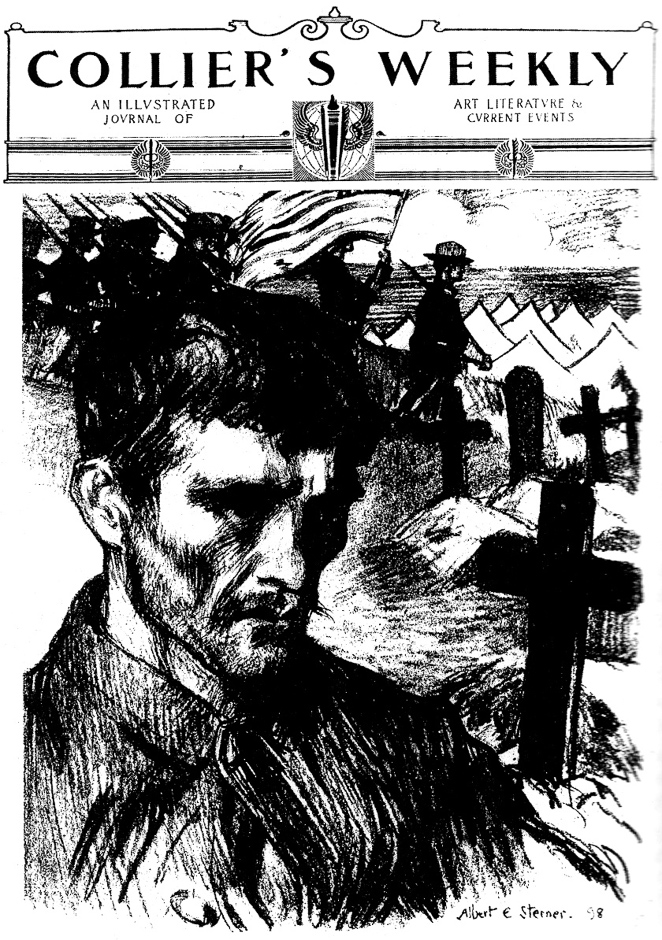
![]()
— Artist Albert E, Sterner, Collier’s Weekly
————————————–
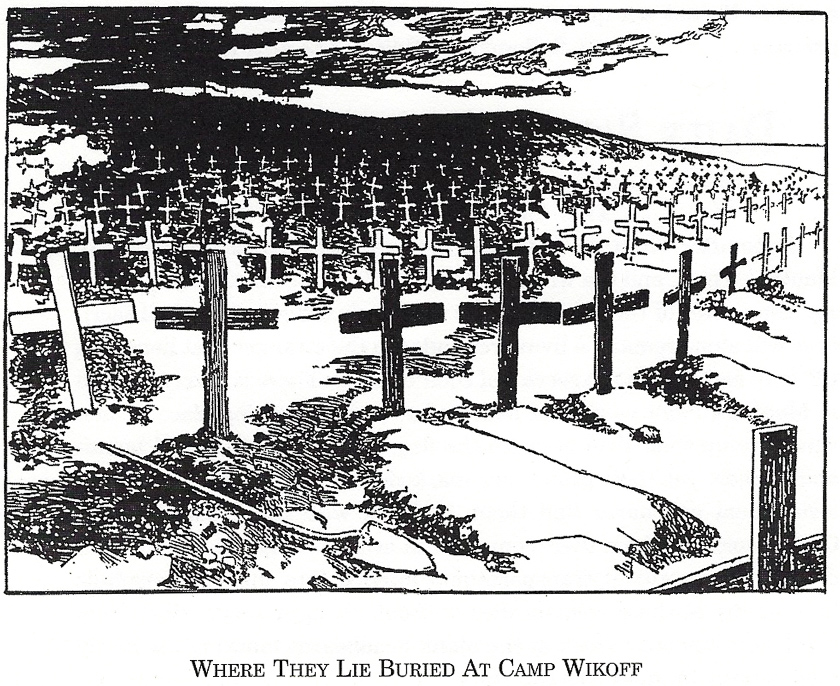
More men died at Camp Wikoff than in any single battle of the Spanish American War.
Approximately 500 died at Camp Wikoff, including five Unknown Soldiers.
Caskets were disinterred and sent to the soldiers’ hometowns,
except for fifty that were re-interred at Cypress Hills National Cemetery, Brooklyn.
— Hayden Jones, Illustrator, The World, September 9, 1898.
They died the heroes’ death as truly as those who fell in the trenches at Santiago, and some day their admiring and grateful countrymen will build on that noble headland a memorial shaft fit for those who in Freedom’s battle have won an undisputed title as “bravest of the brave.”
— John H. Hunt, Editor, Sag Harbor Express.
~~~~~~~~~~~~~~~~~~~~~~~~~~~~~~~~~~~~~~
![]()

“The Bronco Buster” — Frederic Remington’s Bronze Sculpture
Given to Col. Roosevelt by the Rough Riders
————
In bidding farewell to the Rough Riders, Col. Roosevelt said,
“No gift could have been so appropriate as this bronze by Frederic Remington. The men of the West and Southwest, horsemen, riflemen and herders of cattle, have been the backbone of this regiment…Besides the cowpuncher, this regiment contained men from every section of the country, every State of the Union….It gives me extreme pleasure to look around among you and see men of every occupation, men of means and men who work with their hands for a livelihood, and at the same time to know that I have you as friends. You are men of widely different pursuits, yet you stand here side-by-side, you fought shoulder to shoulder…You cannot imagine how proud I am of your friendship and regard….”
Colonel Roosevelt was mustered out of service at 5 PM September 14, 1898.
— Illustration, The World.
— Quote,The Sun, September 13, 1898.
— Report, The Sun, September 15, 1898.
~~~~~~~~~~~~~~~~~~~~~~~~~~~~~~~~~~~~~~
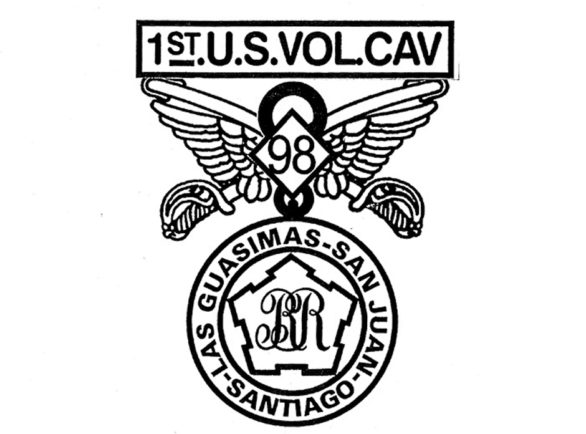
Badge of the “Order of the Roosevelt Rough Riders”
Formed on August 31st, with Lieut. Col. Alexander Brodie, as President; General Leonard Wood & Col. Roosevelt as Vice Presidents. Organizers of The Military Order believed, that it would become as honored an inheritance as any title to nobility. The eldest son of each member would be admitted to the Order on the death of his father — in this way, it was hoped that the name & fame of the cavalry regiment would continue in perpetuity.
— Rendering by George Bloem, 1997.
— The Sun, September 14, 1898.
————————————–
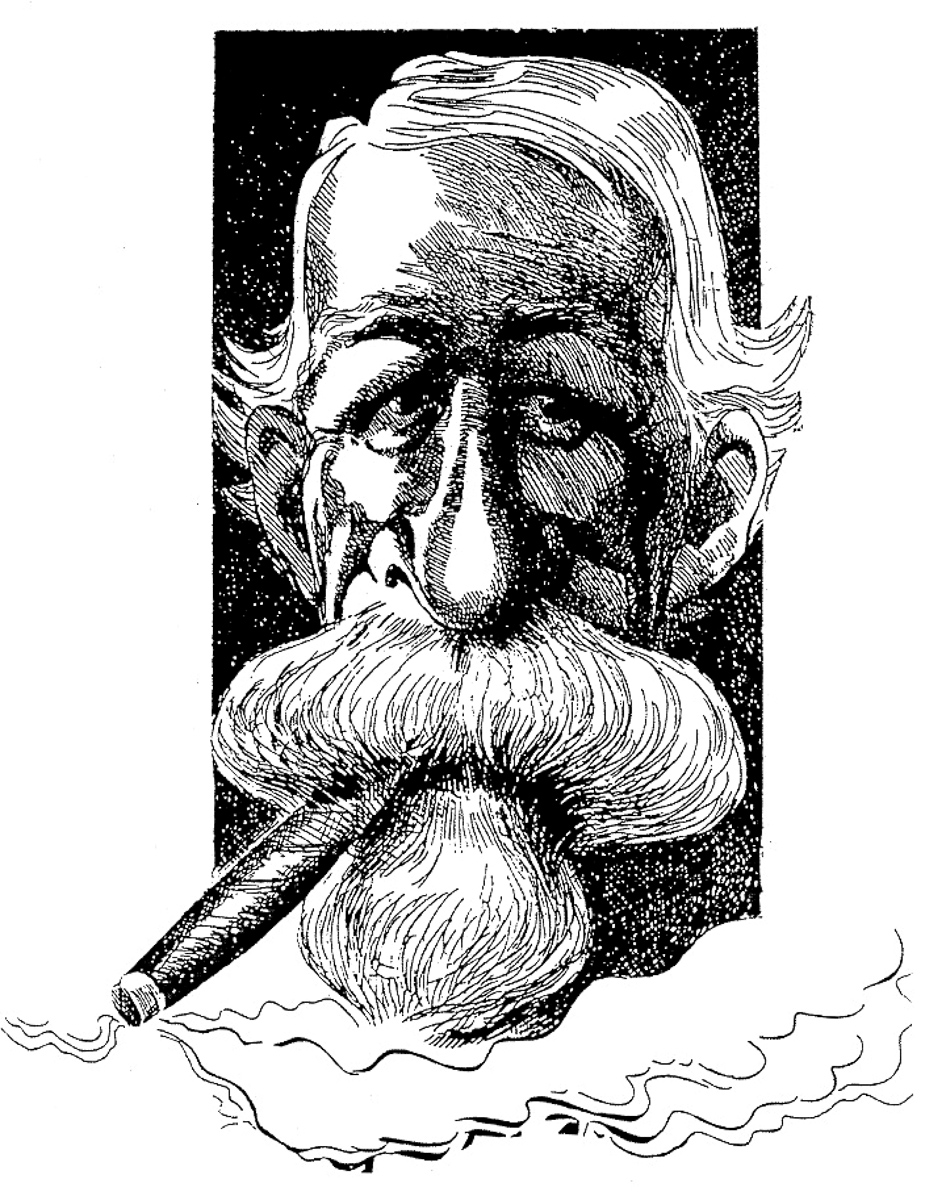
No Forgiveness for Algerism
Men who think more of politics than they do of human life do not understand the feeling
of the American people toward Alger and those that protect him…
— William Randolph Hearst
— George Luks, Artist. The World, September 18, 1898.
— Editorial, New York Evening Journal.
————————————–

When the final chapter of Camp Wikoff comes to be written, the ministering angels from the Long Island Hamptons of both sexes should have their names well-blazoned. The devoted men and women from these Long Island villages , who have given their time, their means and their best efforts to alleviate the sufferings of the soldiers at Montauk Point, deserve and should receive not only the thanks of the War Department, but the gratitude of the people of the United States.
— The Corrector (Sag Harbor)
————————————–
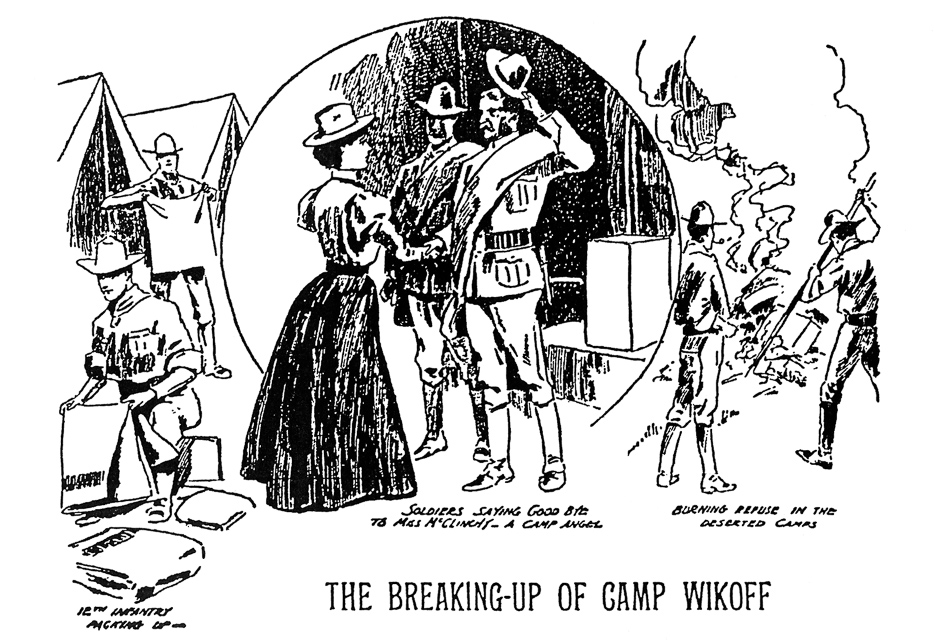
— The World.
————————————–

‘TEDDY’S TERRORS’ VISIT NEW YORK
Upon mustering out of service, the Rough Riders visited New York City. And, New Yorkers found them to be “soft-tongued, mild-mannered boys, civil to the last word, with a sturdy courtesy as winning
as it is unhewed.”
— Williams, Illustrator, The World, September 18, 1898.
————————————–
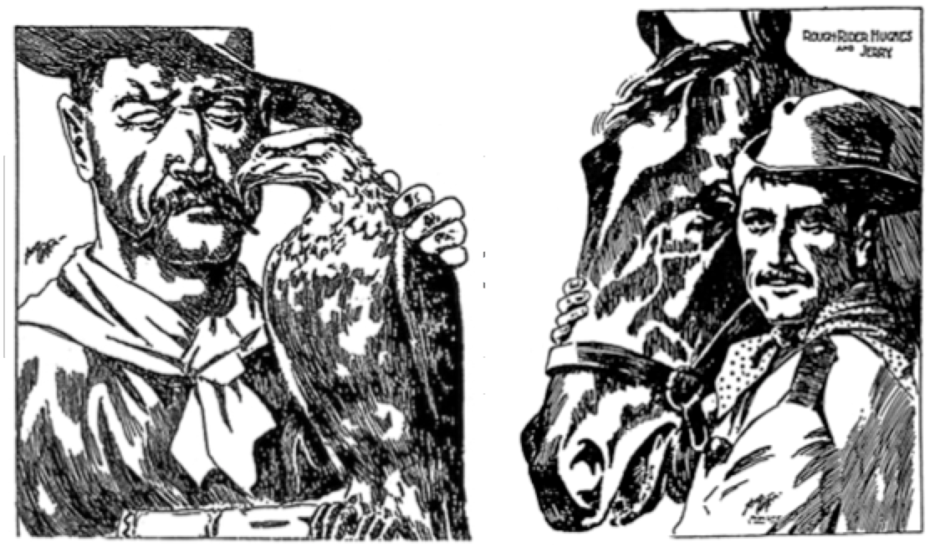
(left) Rough Rider S.A. Kennedy with Teddy, the Rough Riders’ Golden Eagle Mascot.
———
(right) Rough Rider Hughes bought his horse, Jerry, for $ 13 at Auction in NYC,
after the Rough Riders were mustered out of service.
— Carter, Illustrator, The World.
————————————–
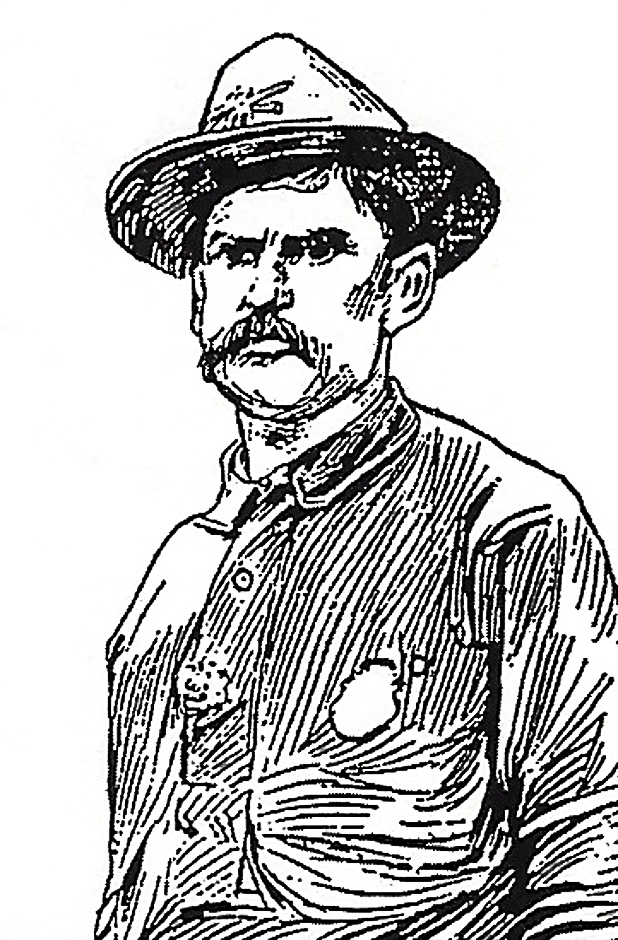
Rough Rider William D. Woods, “Bronco Buster.”
— Boston Globe
————————————–
![]()
![]()
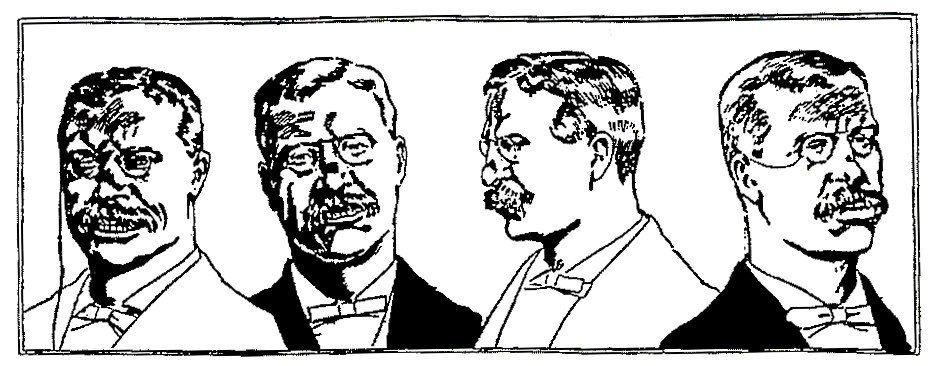
Republican Gubernatorial Candidate Roosevelt at Carnegie Hall, October 5, 1898.
— Carter, Illustrator, The World.
———————-
Of the Rough Riders, Roosevelt said, “They were American soldiers, no more and no less. Living, each one strove incessantly to do even more than his duty, scorning to do less, and ashamed to falter or ask for aid; yet always glad to help a brother who, however willing, was weaker: Dying, each faced with equal courage the fate which, in an instant of time, blots out all the differences that we rear with such infinite labor on this earth. Living and dying, they gave us a lesson in American citizenship, and this lesson which they taught in the war let us profit by as we live in peace.”
The speech ended amid the heartiest and most vociferous applause ever
given a speaker on a New York platform.
— New York Press.
~~~~~~~~~~~~~~~~~~~~~~~~~~~~~~~~~~~~~~
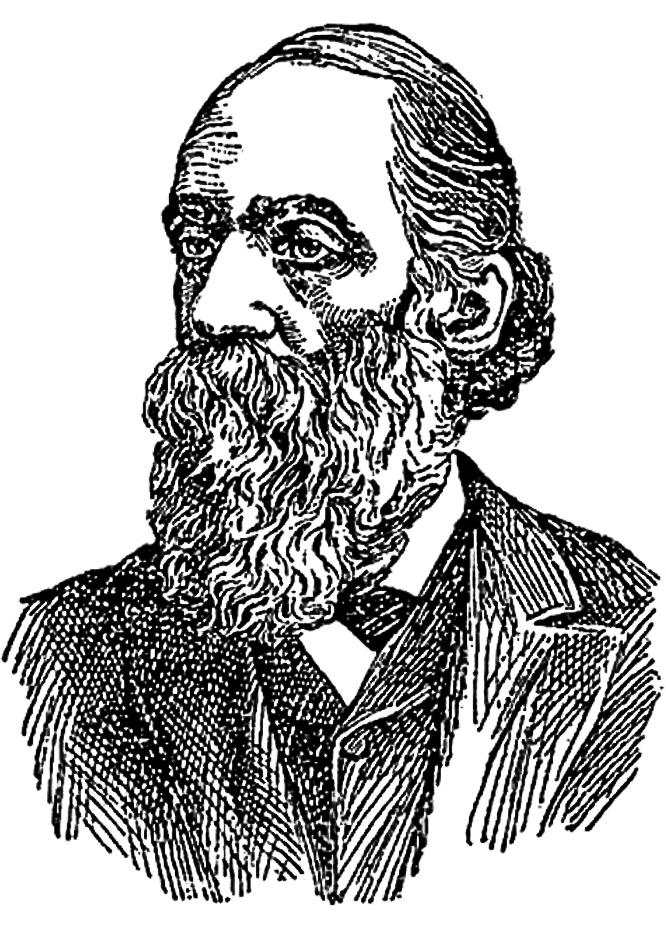
General Joseph Wheeler, Called a ‘Modern Paladin’ by the Washington Post.
Gen. Wheeler referred to Camp Wikoff as an ideal camping place…“We have had there,” he said, “22,500 men direct from the fever-infested swamps of Cuba, besides 7,000 men from southern camps in our own country…When Camp Wikoff was most populous there were twenty-eight square miles of tents, and the scene presented was most beautiful.”
— Editorial, Washington Post, October 6, 1898.
— Report, New York Times, September 27, 1898.
~~~~~~~~~~~~~~~~~~~~~~~~
CAMP WIKOFF ABANDONED
October 9, 1898
Secretary of War Alger issues order for the Seventh United States Infantry, last regiment stationed at Camp Wikoff, to move to posts in Michigan, bringing to a close the great military encampment in Montauk.
— The Sun, October 9, 1898
~~~~~~~~~~~~~~~~~~~~~~~~~~~~~~~~~~~~~~
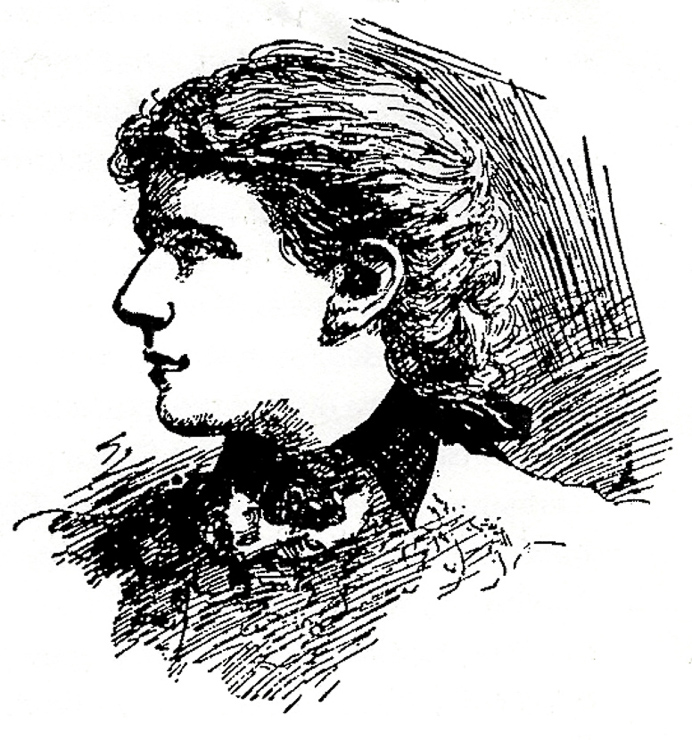
Reubena Hyde Walworth
Miss Reubena Hyde Walworth, daughter of Ellen Walworth, died of typhoid fever in New York City after serving as a Volunteer Nurse in the Detention Hospital at Camp Wikoff. A Vassar graduate & advanced art student, Reubena served as a nurse at Fort Monroe, Virginia, then, at her mother’s request, came to Camp Wikoff to work in the General Hospital; but then, against her mother’s wishes, she volunteered to work in the Detention Hospital, a quarantine facility.
— New York Press, October 19, 1898.
~~~~~~~~~~~~~~~~~~~~~~~~~~~~~~~~~~~~~~

There is a weird gloominess about the place from which one cannot escape as he walks around and sees the buildings, which a month since were fairly alive with human beings, now boarded up and left as sad reminders of the scenes of pleasure, joy, delight, sadness, sorrow and misery, which were alternately presented there during the existence of Camp Wikoff….
— E.S. Boughton, Editor, East Hampton Star, October 29, 1898.
————————————–
======================== POSTSCRIPT ========================
————-
The Whole Republican State Ticket Elected
Wins by Nearly Thirty Thousand Plurality Over Augustus Van Wyck,
the Democratic Nominee
————-
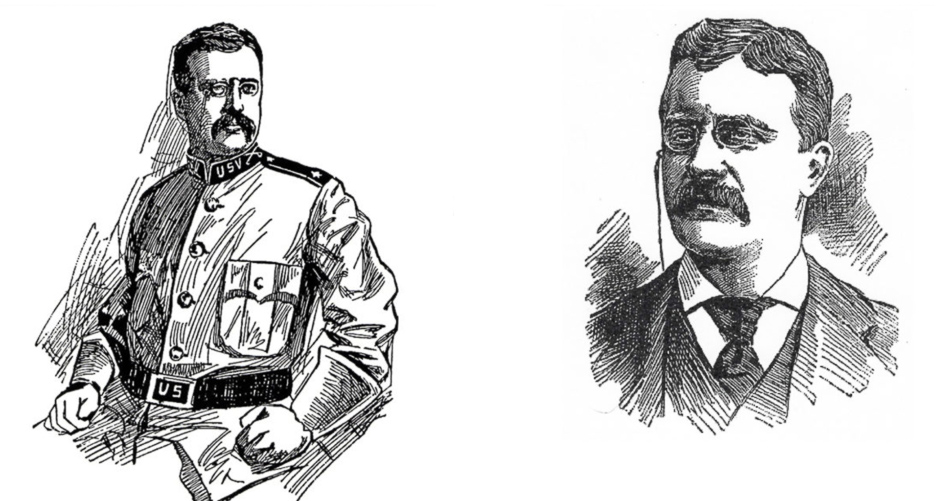
Colonel Roosevelt > NYS Governor Roosevelt
— (left) The Traveler. (right) Boston Globe.
****************************************
Republican Gubernatorial Candidate Roosevelt Elected Governor
of New York State, Tuesday, November 8, 1898.
———————————-
Platt’s Gratitude
“Colonel Roosevelt deserves all honor and credit for the victory in the State, for I am certain that he is the only man who could have carried our standard to victory this year. Besides his strong personality, he possesses remarkable physical resources, which were no small factor in the campaign just ended.”
U.S. Senator Thomas C. Platt
— Commercial Advertiser
———————————-
——————- Roosevelt in 1898 ——————-
- Assistant Secretary of the Navy thru May 10, 1898
- Lieutenant Colonel of the 1st Volunteer Cavalry
- Colonel of the 1st Volunteer Cavalry, July 31st
- Debarks from the Transport Miami at Fort Pond Bay, August 15th
- Republican Gubernatorial Candidate, September 27th
- Elected NYS Governor, November 8th, 1898.
———
Vice President Theodore Roosevelt became President of the United States,
on the death of President McKinley, September 14, 1901, at age 42. .
============================================
© Jeff Heatley, AAQ / East End.
~~~~~~~~~~~~~~~~~~~~~~~~~~~~~~~~~~~~~~~~~~~~~~~~~

SECOND EDITION, 2023
Second Edition published, 2023, by Montauk Historical Society & East End Press
w/ Grant from the Robert David Lion Gardiner Foundation.
For an overview of new edition, please visit this portfolio:
‘BULLY! Col. Roosevelt, The Rough Riders & Camp Wikoff / link
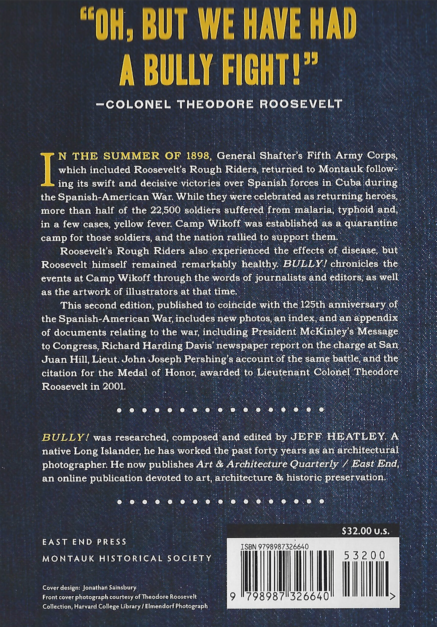
===================================
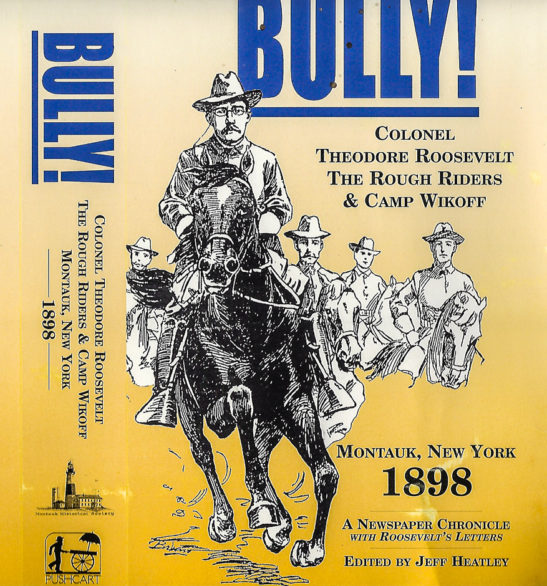
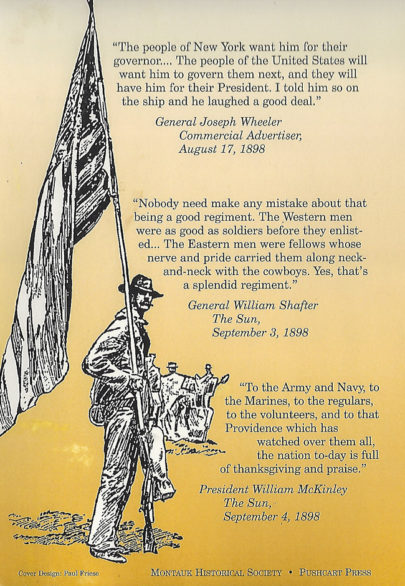
FIRST EDITION, 1998
Published June 30th, 1998 by Montauk Historical Society / Pushcart Press
as part of Suffolk County’s Centennial Celebration of Roosevelt’s Rough Riders.
~~~~~~~~~~~~~~~~~~~~~~~~~~~~~~
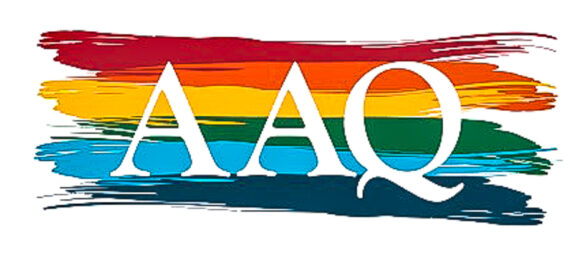
__________________________________________________________________





